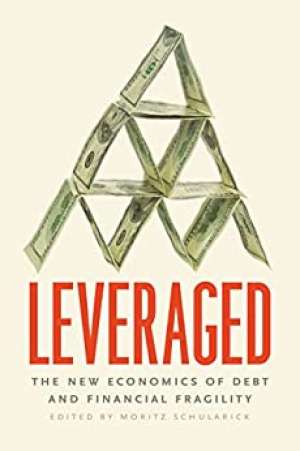26 April 2023
Leveraged
The new economics of debt and financial fragility
Moritz Schularick
2023, University of Chicago Press, 317 pages,
ISBN 0226816931
Reviewer: William A Allen, NIESR

The global financial crisis has drawn renewed attention to the subject of leverage, which was largely ignored in the macro-economic models that were in widespread use before the crisis. This book, edited and helpfully introduced by Moritz Schularick, is a collection of conference papers on the subject. There are several themes.
One is that leverage increases macro-economic fragility: the more leverage there is, the greater the vulnerability of the economy to shocks, because of greater collateral damage from the associated bankruptcies and distress sales. Moreover, there is a kind of ratchet at work. Defaults on private debt – particularly bank failures – can do so much macro-economic damage that governments feel obliged to organise bailouts, thus replacing private debt with government debt. So it is that government debt ratios have more than doubled in the past two decades.
There are some big questions arising from this theme. One of them is the Schumpeter issue. The gale of creative destruction is supposed to promote economic growth by blowing away established but under-performing companies and freeing up resources to be employed by their more productive replacements. Bankruptcies are to be welcomed – not by creditors, of course, but by the public at large as a sign of effective competition. As Holger Mueller notes in his contribution, perhaps there is a choice between relatively stable but slow growth and more variable but on average faster growth.
A second theme is that financial instability can originate within financial markets. Here I think it is important, even if it seems pedantic, to distinguish between financial markets and the people who participate in them. And it is the latter who can be the source of financial instability, through faulty credit judgments, herd behaviour, and reckless risk-taking. Yet it is necessary for credit judgments to be made if economies are going to prosper, and inevitable that some of them will turn out to be faulty. For sure, risk-taking needs to be, but isn’t always, kept within prudent limits. As regards banks, Rüdiger Fahlenbach and Samuel Hanson pin the blame for the financial crisis on bank shareholders, accurately I think; they might also have considered whether the institution of limited liability is desirable for all bank shareholders. Stefania Albanesi reaches the very interesting conclusion that the main triggers for the United States mortgage crisis in 2007-09 were defaults not by sub-prime borrowers but by leveraged investors who owned several pieces of real estate.
Of course the regulatory panoply of minimum ratios and other rules has been greatly reinforced since the financial crisis. It is, however, possible for regulation to be micro-prudent and macro-reckless. One example is the regulation and accounting rules applied to defined-benefit pension funds and their sponsoring companies, which have driven the funds further and further out of equities and into bonds (not to mention liability-driven-investment products). This has made it possible to calculate the future return from the assets with some precision and compare it with the funds’ future liabilities, even if perhaps the calculation is spurious because some of the expected interest payments may not arrive. At the micro level this has a certain attraction for regulators, but at the macro level, it is natural to think that the main source of pensioners’ incomes should be corporate profits and that pension funds should be largely in equities. If pensioners live off interest payments, then who gets the benefit of corporate profits? And who owns so-called British companies? And if pension funds with long horizons can’t take risks, then who can?
Another example is that the Basel 3 leverage ratio applied to banks, which treats all assets the same, bears particularly hard on holdings of low-risk assets like government securities. This is a serious problem for those banks which act as market makers in government securities, and many of them have reduced their capital commitment to those markets: this is one cause (not the only one) of the diminishing liquidity of government securities markets, which is most certainly a potential source of systemic risk.
Some of the papers evoke a kind of nostalgia for the period after the war and before financial liberalisation began in about 1980, when no hint of financial instability emerged. But that period (like most others) was very special: in most countries it was a time of widespread financial repression which had begun during the war, when fiscal dominance was pretty much universal, and continued afterwards. In those circumstances, financial repression and inflation were the only feasible means of restoring financial stability. As Schularick notes, we now have higher government debt ratios; we also have higher interest rates than for the last dozen years. This is alarming, because it aggravates the threat of fiscal dominance of monetary policy and of inflation that central banks cannot subdue.
Schularick claims in his introduction that ‘a new economics of debt, credit and crisis is taking shape’. The papers in the book are generally clearly written and interesting. It is perhaps significant that most of them are historical rather than theoretical in orientation. Perhaps this is an indication of the direction which the new economics is taking. I hope so. In any case, the book is well worth reading.
Listen to William Allen read his review.
Sorry: IE8 cannot display our video content.
